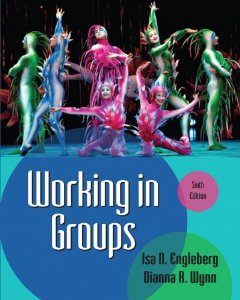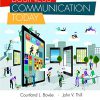Test Bank for Working in Groups 6th Edition Isa N Engleberg
$35.00 Original price was: $35.00.$26.50Current price is: $26.50.
Test Bank for Working in Groups 6th Edition Isa N Engleberg
Instant download Test Bank for Working in Groups 6th Edition Isa N Engleberg pdf docx epub after payment.

TEST BANK CHAPTER 1: INTRODUCTION TO GROUP COMMUNICATION
Multiple Choice
1.1-1. Which of the following situations best represents group communication as defined in the
textbook?
a. People talking in an elevator.
b. People discussing the weather at an airport.
c. Fans cheering at a baseball game.
d. Jury members deliberating a court case.
e. A congregation listening to a sermon.
Difficulty: 2
Question ID: 01.1-01
Page Ref: 3
Answer: d. Jury members deliberating a court case.
1.1-2. A group with 7 members has the potential for _______ different types of interactions.
a. 9
b. 90
c. 666
d. 900
e. 966
Difficulty: 2
Question ID: 01.1-02
Page Ref: 4
Answer: e. 966
1.1-3. What is the ideal group size for a problem-solving discussion?
a. 3–5 people
b. 4–6 people
c. 5–7 people
d. 6–9 people
e. 8–12 people
Difficulty: 2
Question ID: 01.1-03
Page Ref: 4
Answer: c. 5–7 people
1.1-4. According to your textbook, one of the most important factors separating effective groups from
ineffective groups is
a. having a minimum of 5 and a maximum of 12 members in a group.
b. a common goal.
c. strong leadership.
d. member independence and interdependence.
e. group morale.
Difficulty: 2
Question ID: 01.1-04
Page Ref: 6
Answer: b. a common goal.
1.1-5. According to your textbook, a group’s context refers to
a. the type and size of the group.
b. the group’s physical and psychological setting.
c. the group’s purpose, history, and status.
d. the characteristics of and relationships among group members.
e. all of the above.
Difficulty: 2
Question ID: 01.1-05
Page Ref: 12
Answer: e. all of the above.
1.1-6. To which basic element of communication is Grace giving special attention when she prepares
for an important group meeting by making sure her business suit is pressed, that her hair is
well-groomed, that her perfume is pleasant but subtle, and that she takes a breath mint before
entering the meeting room?
a. channels
b. external noise
c. feedback
d. verbal message
e. internal noise
Difficulty: 3
Question ID: 01.1-06
Page Ref: 12
Answer: a. channels
1.1-7. In a communication transaction, feedback represents
a. a group’s physical and psychological environment.
b. anything that interferes with or inhibits effective communication.
c. the media through which group members share messages.
d. the response or reaction to a message.
e. ideas, information, opinions, and/or feelings that generate meaning.
Difficulty: 2
Question ID: 01.1-07
Page Ref: 12
Answer: d. the response or reaction to a message.
1.1-8. Which of the following examples best illustrates the systems theory principle that “systems try to
maintain balance in their environment”?
a. Members may take time off to “play” when work becomes too intense.
b. Members may unexpectedly come up with new ideas and techniques.
c. Effective groups have clear goals.
d. Groups suffer if members fail to cooperate.
e. Groups rely on member input to achieve a common goal.
Difficulty: 3
Question ID: 01.1-08
Page Ref: 5
Answer: a. Members may take time off to “play” when work becomes too intense.
1.1-9. The cooperative interaction of several factors that results in a combined effect greater than the
total of all individual parts is referred to as
a. interaction.
b. common goals.
c. interdependence.
d. synergy.
e. working.
Difficulty: 2
Question ID: 01.1-09
Page Ref: 13
Answer: d. synergy.
1.1-10. A stamp collecting club is an example a
a. self-help group.
b. social group.
c. learning group.
d. service group.
e. public group.
Difficulty: 1
Question ID: 01.1-10
Page Ref: 6-8
Answer: b. social group.
1.1-11. Your family is an example of a
a. primary group.
b. social group.
c. public group.
d. service group.
e. none of the above
Difficulty: 1
Question ID: 01.1-11
Page Ref: 6-8
Answer: a. primary group.
1.1-12. A local Alcoholics Anonymous chapter is an example of a
a. primary group.
b. self-help group.
c. learning group.
d. service group.
e. public group.
Difficulty: 2
Question ID: 01.1-12
Page Ref: 6-8
Answer: b. self-help group.
1.1-13. Guests who appear on talk shows and interact with other guests for the benefit of an audience
are participating in a
a. symposium.
b. forum.
c. panel discussion.
d. governance group.
e. service group.
Difficulty: 1
Question ID: 01.1-13
Page Ref: 7
Answer: c. panel discussion.
1.1-14. Members of a PTA getting together to hold a carnival for elementary school students
represents what type of group.
a. symposium
b. forum
c. civic group
d. governance group
e. self-help group
Difficulty: 2
Question ID: 01.1-14
Page Ref: 7
Answer: c. civic group
1.1-15. A college appoints a moderator and holds an open discussion to provide students with the
opportunity to ask questions and express their concerns regarding a proposed increase in
tuition. This setting for group communication is an example of a
a. symposium.
b. forum.
c. panel discussion.
d. governance group.
e. service group.
Difficulty: 2
Question ID: 01.1-15
Page Ref: 7
Answer: b. forum.
1.1-16. A college’s Board of Trustees that makes public policy decisions may be classified as a
a. symposium.
b. forum.
c. panel discussion.
d. governance group.
e. service group.
Difficulty: 1
Question ID: 01.1-16
Page Ref: 7
Answer: d. governance group.
1.1-17. Which of the following characteristics demonstrates one of the disadvantages of working in
groups?
a. Groups make better decisions when working on complex tasks.
b. Working in groups enhances member learning.
c. Groups require significant time, energy, and resources.
d. Groups are often more creative than members working alone.
e. Members usually enjoy working with others in groups.
Difficulty: 2
Question ID: 01.1-17
Page Ref: 8-11
Answer: c. Groups require significant time, energy, and resources.
1.1-18. A virtual group is one which
a. relies on technology to communicate.
b. exists only for a short period of time.
c. lacks a leader.
d. lacks a clear purpose.
e. has the same dynamic as other groups.
Difficulty: 1
Question ID: 01.1-18
Page Ref: 8
Answer: a. relies on technology to communicate.
1.1-19. Statements that explain or predict how people communicate are
a. theories.
b. strategies.
c. skills.
d. resources.
e. rules.
Difficulty: 1
Question ID: 01.1-19
Page Ref: 12
Answer: a. theories.
1.1-20. When seeking to resolve group tensions, the dialectic approach recommends a
__________________ approach.
a. compromise
b. either/or
c. both/and
d. approach/avoidance
e. task/maintenance
Difficulty: 2
Question ID: 01.1-20
Page Ref: 14
Answer: c. both/and
1.1-21. All of the following pairs of common folk proverbs illustrate the contradictory nature of
dialectic tensions EXCEPT:
a. “Opposites attract” and “Birds of a feather flock together.”
b. “Two’s company, three’s a crowd” and “The more the merrier.”
c. “Look before you leap” and “He who hesitates is lost.”
d. “Waste not, want not” and “Music makes the world go ’round.”
e. “To know him is to love him” and “Familiarity breeds contempt.”
Difficulty: 3
Question ID: 01.1-21
Page Ref: 13-14
Answer: d. “Waste not, want not” and “Music makes the world go ’round.”
1.1-22. In group dialectic terms, effective groups balance structure and
a. heterogeneity.
b. disengagement.
c. spontaneity.
d. engagement.
e. individual goals.
Difficulty: 2
Question ID: 01.1-22
Page Ref: 14-18
Answer: c. spontaneity.
1.1-23. In dialectic terms, effective groups balance conflict with
a. conformity.
b. cohesion.
c. structure.
d. closed systems.
e. social dimensions.
Difficulty: 2
Question ID: 01.1-23
Page Ref: 14-18
Answer: b. cohesion.
1.1-24. In dialectic terms, effective groups balance task dimensions with
a. conformity dimensions.
b. cohesion dimensions.
c. structure dimensions.
d. closed dimensions.
e. social dimensions.
Difficulty: 2
Question ID: 01.1-24
Page Ref: 14-18
Answer: e. social dimensions.
People also search:
Working in Groups
Working in Groups Isa N Engleberg
Working in Groups Isa N Engleberg 6th
Working in Groups Isa N Engleberg 6th Test Bank
Test Bank for Working in Groups 6th Edition Isa N Engleberg Download











